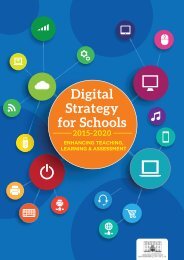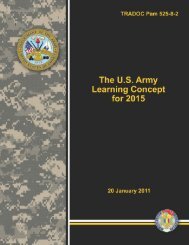Digital Strategy for Schools
TKmef
TKmef
Create successful ePaper yourself
Turn your PDF publications into a flip-book with our unique Google optimized e-Paper software.
1. INTRODUCTION<br />
There is growing evidence that “digital technologies change the way students learn, the way teachers<br />
teach, and where and when learning takes place” (21st Century Learning Reference Group, 2014;<br />
p.4) 11 . There is widespread understanding that learning today needs to entail more than knowledgeacquisition;<br />
there needs to be an equally strong emphasis on skill-development, particularly 21st<br />
century skills or Key Skills 12 .<br />
Learners need “more open-ended learning experiences that develop the learners’ higher-order<br />
thinking, creativity, independence, collaborating and ownership of learning” (Department of<br />
Education and Skills, 2013; p.20) 13 . When ICT is used effectively, it can provide opportunities <strong>for</strong> all<br />
teachers, students and parents/guardians to develop these Key Skills.<br />
Embedding ICT in teaching, learning and assessment is a complex endeavour and the mere presence<br />
of ICT in a school does not equate to its effective use (OECD, 2015) 14 . The 2013 ICT in <strong>Schools</strong><br />
Census Report 15 (Cosgrove et al., 2013a), herein after referred to as the Census Report, found that<br />
ICT has often taken the place of older technologies, such as books or whiteboards, and the role of<br />
the teacher and the learner remains unchanged. Furthermore, the Horizon Report Europe 2015<br />
K12 Edition 16 identifies main trends, developments in technology and challenges that are very likely<br />
to impact on education across the world. Referenced trends include rethinking how schools work<br />
and a shift from students as consumers to creators. Major challenges identified include rethinking<br />
the role of teachers and scaling teaching innovations (see Figure 1).<br />
The Census Report highlights the potential role of ICT in helping to trans<strong>for</strong>m teaching, learning and<br />
assessment practices in a very positive way over the next five years. Ultimately, such trans<strong>for</strong>mation<br />
will serve to enhance student learning and prepare our young people to live, learn and work in a<br />
modern globalised society.<br />
11<br />
Future Focused Learning in Connected Communities (2014) (http://www.education.govt.nz/assets/Documents/Ministry/Initiatives/<br />
FutureFocusedLearning30May2014.pdf)<br />
12<br />
Current policy trends and issues in teacher education and curricular re<strong>for</strong>m (2013) (http://www.education.ie/en/Press-Events/<br />
Speeches/2013-Speeches/SP13-02-22.html)<br />
13<br />
Chief Inspector’s Report (2010-2012) ( http://www.education.ie/en/Publications/Inspection-Reports-Publications/Evaluation-Reports-<br />
Guidelines/Chief-Inspector%E2%80%99s-Report-2010-2012-Main-Report.pdf)<br />
14<br />
OECD, New approach needed to deliver on technology’s potential in schools (2015)<br />
(http://www.oecd.org/education/new-approach-needed-to-deliver-on-technologys-potential-in-schools.htm)<br />
15<br />
The 2013 ICT Census in <strong>Schools</strong> - Main Report (http://www.erc.ie/documents/ict_census2013_mainreport.pdf)<br />
16<br />
NMC Horizon Report (2015) (http://www.nmc.org/publication/nmc-horizon-report-2015-k-12-edition/)<br />
11




